Smart thermostats are a great way to control the temperature of your entire home from the comfort of your favorite chair. More importantly, they can also be a great way to save money. And, when it comes to smart thermostats, few companies can compete with what Nest has to offer.
In this article, we’ll take a closer look at and compare two of the three Nest smart thermostats currently on the market, the Nest Thermostat and the Nest Learning Thermostat.
One model is significantly more expensive than the other and comes with more features, but how do these two smart home thermometers compare? Read this Nest Thermostat vs Nest Learning Thermostat article to learn about the key differences between these two models.
Nest Thermostat vs Nest Learning Thermostat
| Features | Nest Thermostat | Nest Learning Thermostat |
|---|---|---|
| Humidity Sensor | Yes | Yes |
| Farsight | No | Yes |
| Battery Backup | Internal Rechargeable | Replaceable AA |
| Display Size | 2.4 Inches | 2 Inches |
| Nest Temperature Sensor Compatibility | No | Yes |
| Wi-Fi | Yes | Yes |
| Android App | Yes | Yes |
| iOS App | Yes | Yes |
| Works With Google Assistant | Yes | Yes |
| Works With Amazon Alexa | Yes | Yes |
| Color Options | Snow, Sand, Fog, Charcoal | White, Black, Copper, Polished Steel, Stainless Steel, Brass, Mirror Black |
| Warranty | 1 Year | 2 Years |
| Price | Check Price on Amazon | Check Price on Amazon |
Nest Thermostat
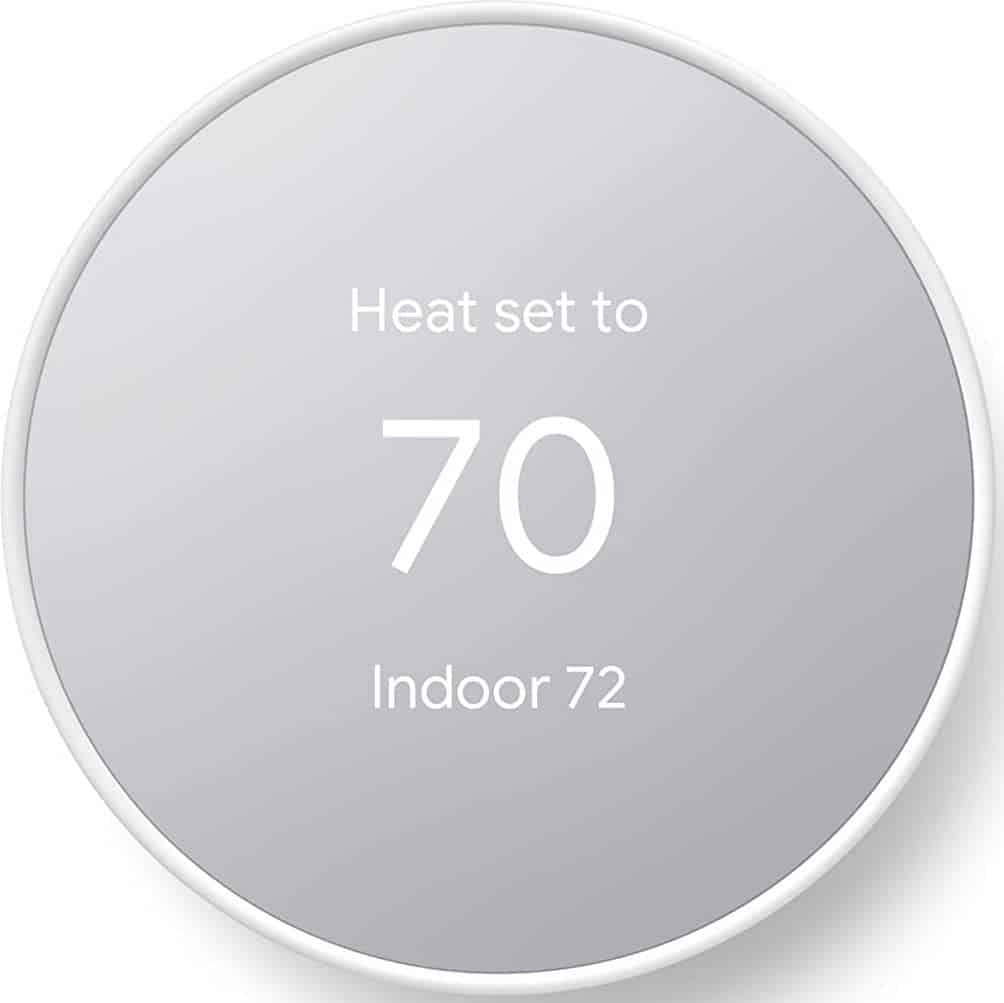
The Nest Thermostat is Google’s most affordable smart home thermostat. It targets consumers that don’t want to spend a more significant amount of money for a Nest Thermostat E or a Nest Learning Thermostat. It features great design and even more impressive characteristics. Here’s a closer look at Nest Thermostat’s pros and cons:
Pros:
- Affordable smart home thermostat
- Supports Google Assistant
- Humidity sensor
- Easy-to-use Android and iOS apps
Cons:
- Compatible with fewer HVAC systems
- Lacks an internal rechargeable battery feature
Nest Learning Thermostat

The Nest Learning Thermostat is undoubtedly an impressive smart thermostat, but its price might deter potential buyers. Still, it features a stylish design, is easy to use, and comes with a handful of standout features. Here are the biggest advantages and disadvantages of the Nest Learning Thermostat:
Pros:
- Compatible with more HVAC systems
- Learning ability
- Supports Google Assistant
- Internal rechargeable battery
Cons:
- Significantly more expensive
- No built-in Amazon Alexa feature
Nest Learning Thermostat vs Nest Thermostat – Features Face to Face
Design and Styling
Looking at their size, both thermostats have the same diameter, measuring in at 3.3 inches. That said, this is where the design similarities come to a stop. The Nest Learning Thermostat is heavier and slightly deeper, meaning that it sticks out a bit more when mounted on your wall.
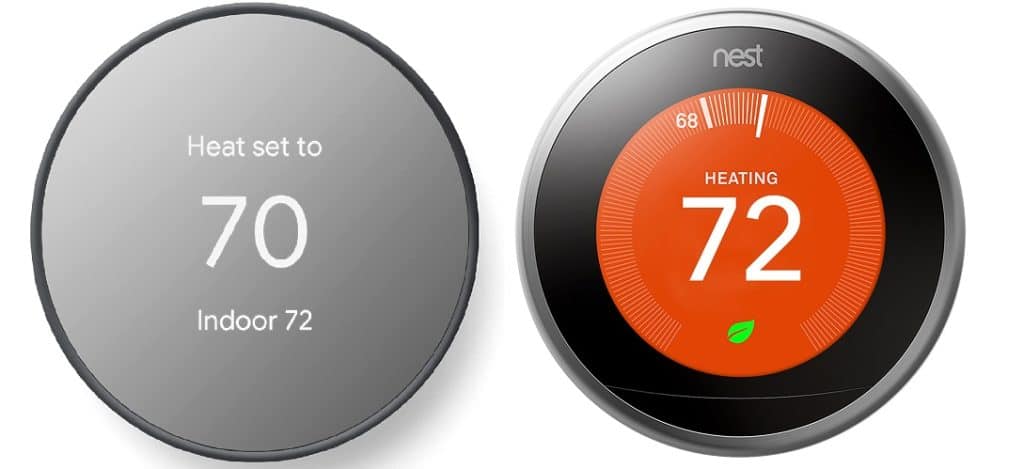
Comparing materials used for the device housing, the Nest Thermostat comes with a basic design and more affordable plastic housing. On the other hand, the Nest Learning Thermostat has a more premium feel to it, as it features a metal trim. That said, you can find a Nest Thermostat Trim Kit in Google Store if you want to add a more premium feel to your Nest Thermostat.
Both thermostats offer you a good selection of colors to choose from, although the Nest Learning Thermostat provides more options. The Nest Learning Thermostat offers seven color options. These are White, Black, Copper, Polished Steel, Stainless Steel, Brass, and Mirror Black. The Nest Thermostat lets you choose from four color options, Snow, Sand, Fog, and Charcoal.
Display
Besides the major design and styling differences, the two thermostats also have differing displays. More specifically, the Nest Thermostat uses a basic plastic display that Google calls “mirror display.” This is a standard QVGA IPS LCD screen with mirrored glass lens.
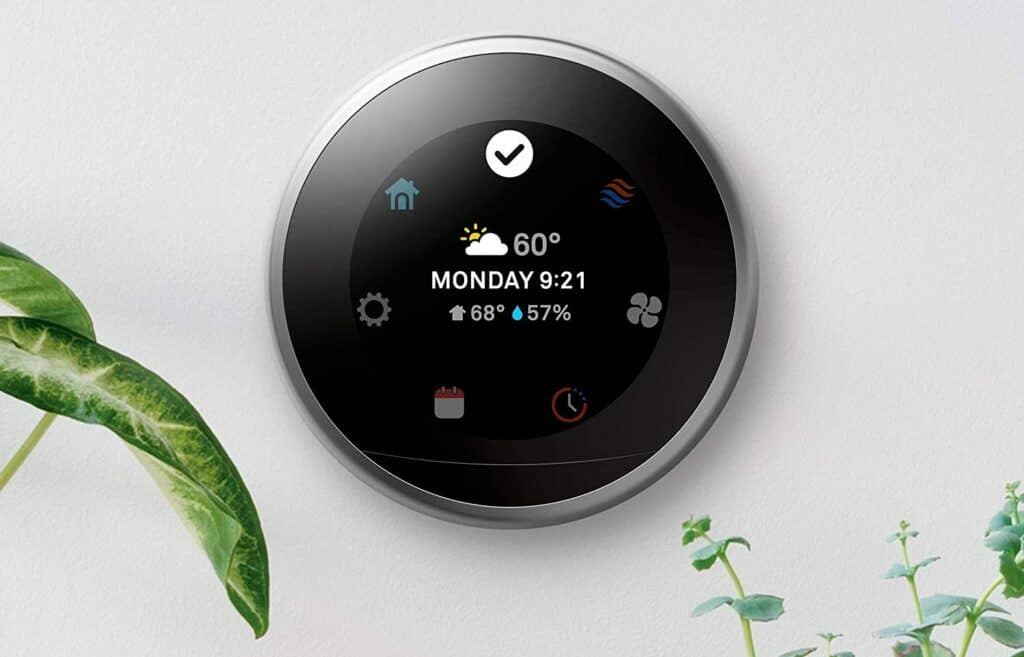
In comparison, the more expensive Nest Learning Thermostat comes with a better display. This thermostat features a high-resolution digital display with Farsight. This screen shows you the time, temperature, and weather, which you can easily navigate through by pressing and rotating the metal ring that wraps around the device’s circumference.
The Nest Thermostat does have a slightly larger display, 2.4 inches, compared to Nest Learning Thermostat’s 2-inch display. However, the Nest Learning Thermostat boasts a better resolution, as its screen has 480 x 480 pixels compared to the Nest Thermostat’s 240 x 320 pixels.
Temperature Controls
There are no considerable differences between the two thermostats regarding how you control the temperature. On both thermostats, you control the temperature by rotating the ring. You can also click it to enter the Nest system and access additional temperature controls.
Installation
A big advantage in terms of the overall user convenience of both thermostats is that you can install them yourself without needing help from a licensed professional. That said, if you’ve never done similar tasks, we recommend opting for a professional installation. This is because there are a handful of things to be mindful of when installing the Nest Thermostat and the Nest Learning Thermostat.
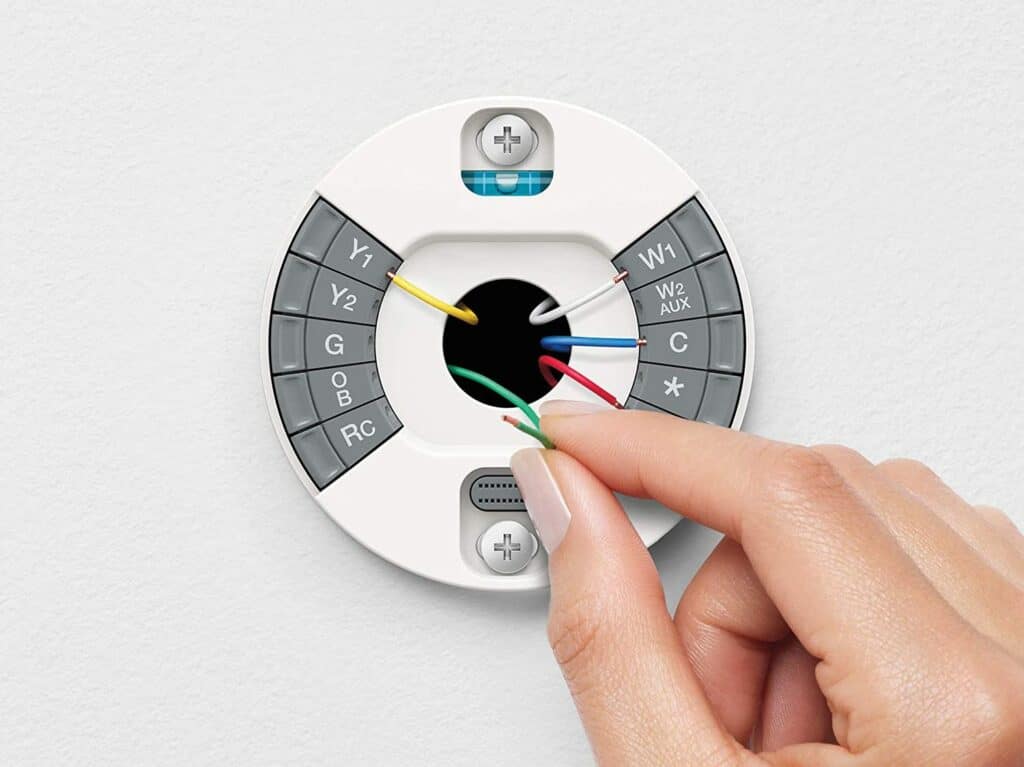
If you opt for a professional installation, it will cost you an additional $99. The installation charge is the same for both models. Additionally, the price is only for the first device. Each subsequent device comes with a $59 installation fee.
Compatibility
The Nest Learning Thermostat has the edge in compatibility, as it works with more HVAC systems. While both thermostats offer compatibility with 24V heating and cooling systems, the Nest Thermostat works with 85% of HVAC systems, while the Nest Learning Thermostat works with 95% of HVAC systems. With that in mind, you should be certain that your HVAC supports one or both of these products before placing an order.

Fortunately, Google created an excellent Compatibility Checker. Using this tool, you can quickly check whether or not your system supports one of these two thermostats before purchasing a device. Additionally, we should mention that both thermostats work with all common fuel types. This includes natural gas, oil, and electricity.
Remote Sensors
This is another crucial category in which the Nest Learning Thermostat has an advantage over the Nest Thermostat. The Nest Learning Thermostat is compatible with the Nest Temperature Sensor. This is a wireless temperature sensor that communicates with the thermostat, telling it the temperature in the room where you place it.
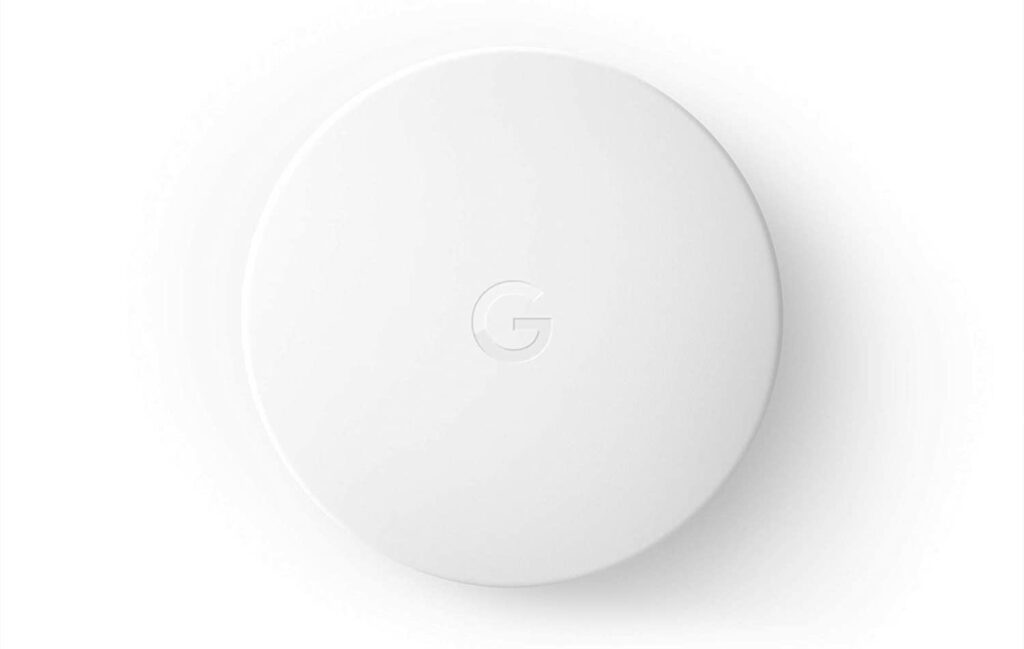
You can connect up to six temperature sensors with the Nest Learning Thermostat. These devices provide you with additional control for more precise temperature control. For example, you can put temperature sensors in your bedroom, kitchen, or living room and keep them cool or warm regardless of the temperature of the room where your Nest Learning Thermostat is installed.
The remote Nest Temperature Sensor is very easy to set up, and you won’t need any professional help. Just place it on a shelf or hang it on the wall in the room where you want to use it. Apart from being compatible with the Nest Learning Thermostat, these smart remote sensors are compatible with Nest Thermostat E smart home devices.
App Usage

The setup process differs in these two thermostats, as you set up the Nest Thermostat through the Google Home App. Alternatively, you need the Nest app to set up the Nest Learning Thermostat. That said, both apps offer very similar features in terms of the supported in-app actions.
Using the Google Home or Nest app, you can change the temperature, select a heating/cooling mode, use a temperature preset, turn on the fan, and use other controls. Additionally, both devices can work with Amazon Alexa but don’t come with Amazon Alexa built-in support.
Ease of Use
Both models can automatically turn down when you leave home. What’s more, they enable you to control and set temperature preferences remotely through the Google Home app. The Nest Learning Thermostat provides you with greater ease of use, as it can learn your temperature preferences and make changes accordingly. In other words, it will lower or increase indoor temperature, keep you feeling pleasant, and save on your utility bills.

The Nest Thermostat lacks this ability. That said, if you want the Nest Thermostat to implement these changes without your input, you can set specific schedules. Other than that, the Nest Thermostat pretty much entirely relies on manual input. Additionally, you can also control both thermostats with Google Assistant.
Average Utility Bill Savings
Average utility bill savings are hard to specify, as individual savings can vary significantly between households. That said, according to two independent studies, the two thermostats offer nearly identical energy savings. These thermostats can save an average of 10% to 12% on heating bills. Moreover, they can save around 15% on cooling bills.
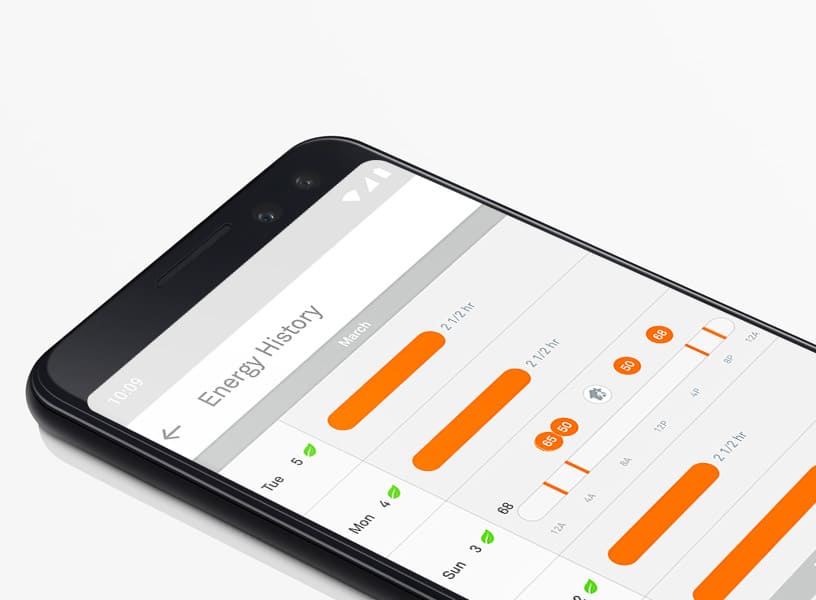
Translating this into real-world numbers means that the Nest Thermostat and the Nest Learning Thermostat can save you between $130 and $145 on utility bills. Based on this information and the two products’ prices, you can expect the Nest Thermostat to pay for itself in just one year, and the Nest Learning Thermostat to do so in two years.
Warranty
The Nest Thermostat comes with a one-year warranty, which isn’t very impressive, to say the least. Moreover, this is yet another category in which the Nest Learning Thermostat outperforms the Nest Thermostat, as it offers you a two-year warranty. Again, the Nest Learning Thermostat proves to be a better choice, and the longer warranty is helpful, seeing that this product is also significantly more expensive.
Battery
Both smart thermostats are equally impressive in terms of their monthly power consumption, as they consume less than 1 kWh/month. That said, the two devices differ when it comes to the type of battery they use. The Nest Thermostat draws primary power from your HVAC system wires. Additionally, it includes two AAA alkaline batteries as a backup.
In comparison, the Nest Learning Thermostat comes with a built-in rechargeable lithium-ion battery. This feature makes the Nest Learning Thermostat more independent and convenient than the standard Nest Thermostat and a better performer in this regard.
Related Read: Nest Thermostat Battery Won’t Charge: How to Fix
Standout Features
The most significant standout feature you should know about is the Nest Learning Thermostat’s learning ability. This automatic temperature adjective feature ensures optimal indoor living conditions, without you having to think about anything.
In addition, as we’ve briefly mentioned in the display comparison section, the Nest Learning Thermostat comes with a Farsight feature. Farsight displays information such as the temperature, time, or the weather, in a large visual format. This makes it easier for you to read across the room.
Lastly, the remote Temperature Sensor support is another standout feature you can only find in the Nest Learning Thermostat. Unfortunately, you won’t find any significant standout features in the Nest Thermostat.
Price
If all of the differences we’ve highlighted in this article so far aren’t enough to give you a hint as to which is the premium device, looking at the two products’ price tags will surely do so. The Nest Learning Thermostat costs twice as much as the Nest Thermostat.
More specifically, comparing the price points in Google Store, we can see that the Nest Thermostat costs $129.99 or less at Amazon, while the Nest Learning Thermostat costs $259.99 or less at Amazon. You might find rebates, rewards, or special offers from your energy provider that could help you purchase these smart thermostats for less money. Additionally, the Nest Temperature Sensors typically cost $39 per device or $99 per 3-pack at Amazon. These prices are at the time of this post’s writing.
Conclusion
Although the two smart home devices are similar in some areas, the Nest Learning Thermostat outperforms the basic Nest Thermostat in several key categories. That said, it’s also considerably more expensive. So, to sum up this Nest Thermostat vs Nest Learning Thermostat comparison article, which smart thermostat is right for you?
With this question in mind, if you’re looking for a more budget-friendly option, the Nest Thermostat is the better choice. On the other hand, if you want a more sophisticated smart home device with better compatibility, more stylish design, and better features overall, the more advanced Nest Learning Thermostat is a clear winner.
Moreover, if you’re concerned about your home’s environmental impact, the Nest Learning Thermostat, coupled with the Nest Temperature Sensors, is the way to go. That said, if you opt for this model, you should keep in mind that the sensors are an extra expense worth factoring in.